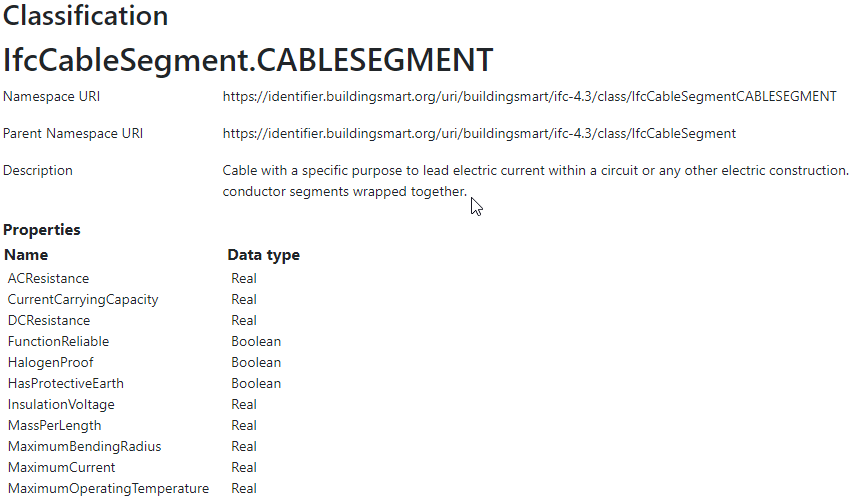SemanticBSDD
Improving the GraphQL, JSON and RDF Representations of buildingSmart Data Dictionary
Outline
- Highlight the defects in the original GraphQL implementation of bSDD
- Overview the refactored solution proposed by Ontotext
- Overview data quality issues
- Overview the proposed improvements
bSDD GraphQL Schema: Voyager
Voyager
Original GraphQL: Findings (1/3)
- Reference entities
ReferenceDocument,Country,Unit,Languageare disconnected from the rest of the schema - Relation entities have only an incoming link but no outgoing link
- Many entities cannot be queried directly from the
Root - No backward arrows to get from a lower-level entity back to its “parent” entity
- A number of parallel arrows. GraphQL schema can use parameters to distinguish between the different uses
Original GraphQL: Findings (2/3)
At the high level of detail:
PropertyandClassificationPropertyare very similar, but there’s no inheritance/relation between themPropertyValueandClassificationPropertyValueare exactly the same, so can be reduced to one entity
Original GraphQL: Findings (3/3)
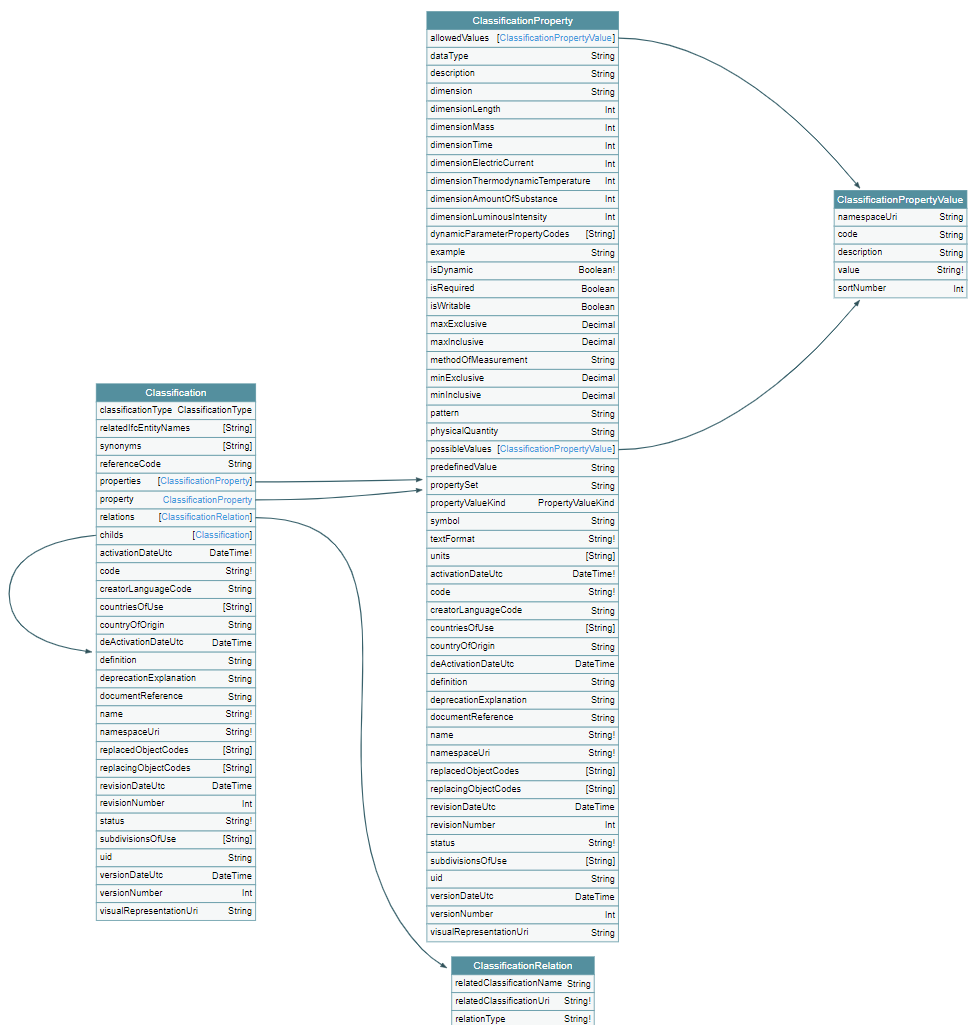
Mixture of singular/plural in property names(*)
property/properties, relations, synonyms, countriesOfUse, relatedIfcPropertyNames, etc.
(*) - already discussed at forums.buildingsmart.org
bSDD Refactored Schema: PlantUML
PlantUML is used with soml2puml convertor tool

Refactored GraphQL: Improvements
- All entities are queryable directly from the
Root - No parallel links, use GraphQL query parameters instead
- Pagination for bulk query results
- GraphQL syntax highlight, keyboard shortcuts, search in the query text, query response errors
- Each link is named the same as target entity
- Navigation between entities is bidirectional
- A single entity
PropertyValueis used by bothPropertyandClassificationProperty - Property names are in singular
GraphiQL
Refactored bSDD: SPARQL Endpoint
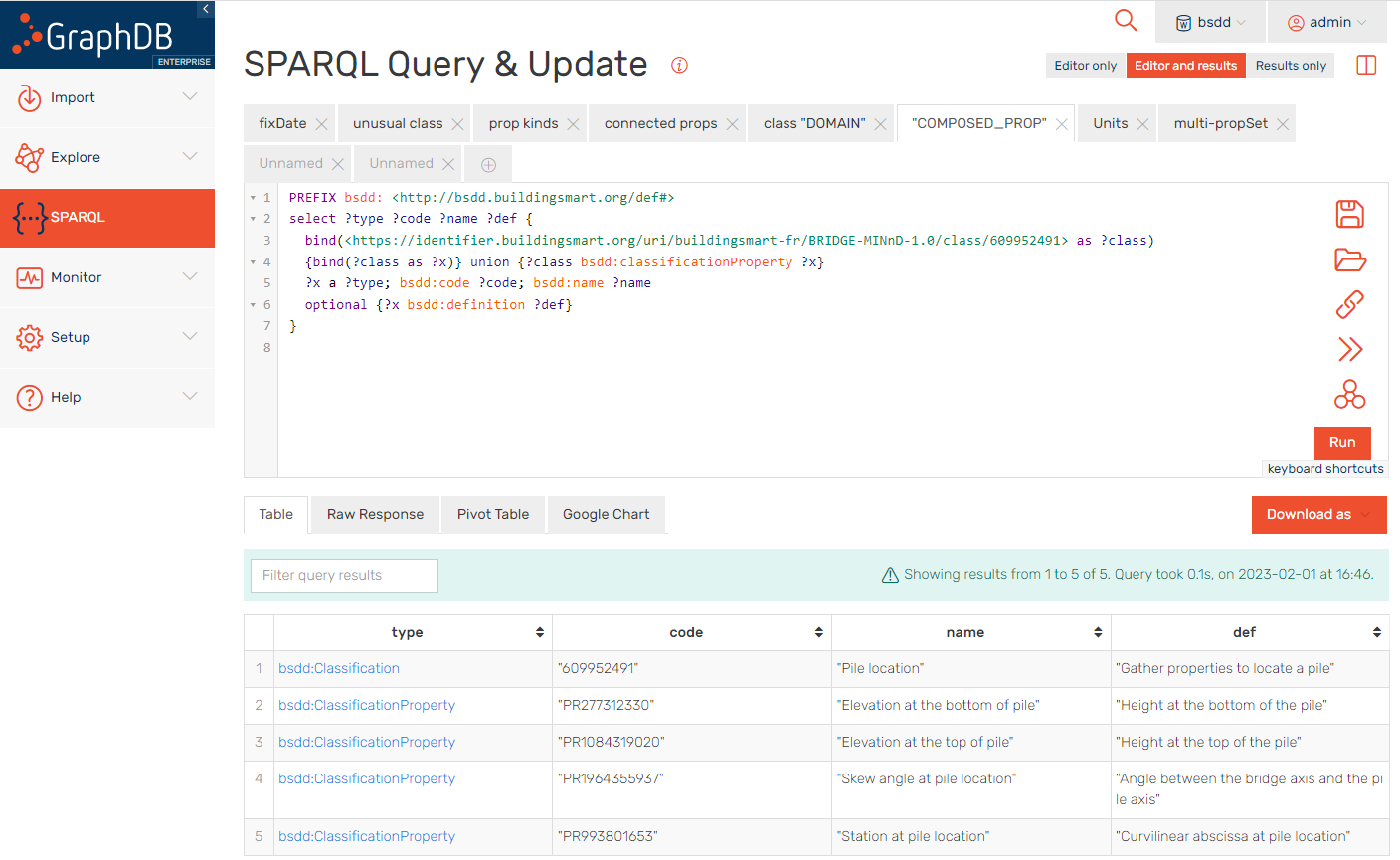
Suggested Improvements
buildingSMART Feedback
buildingSMART International started to analyse the suggested improvements
| Status | Count |
|---|---|
| DISMISSED | 6 |
| NEED MORE INFO | 5 |
| SOLUTION IN PROGRESS | 12 |
| SOLVED | 4 |
| TO BE ANALYSED | 21 |
| TO DO | 13 |
| Grand Total | 61 |
Live spreadsheet with status/solution for each of suggested improvements
Presentation
- Uniform identification for the search
- Equal data retrieved from different API
- Improve URL structure and consistency
Uniform Identification
February 2023: IfcCableSegment in Web UI has URL: https://search.bsdd.buildingsmart.org/Classification/Index/58453
May 2023: IfcCableSegment in Web UI has another URL: https://search.bsdd.buildingsmart.org/Classification/Index/70992
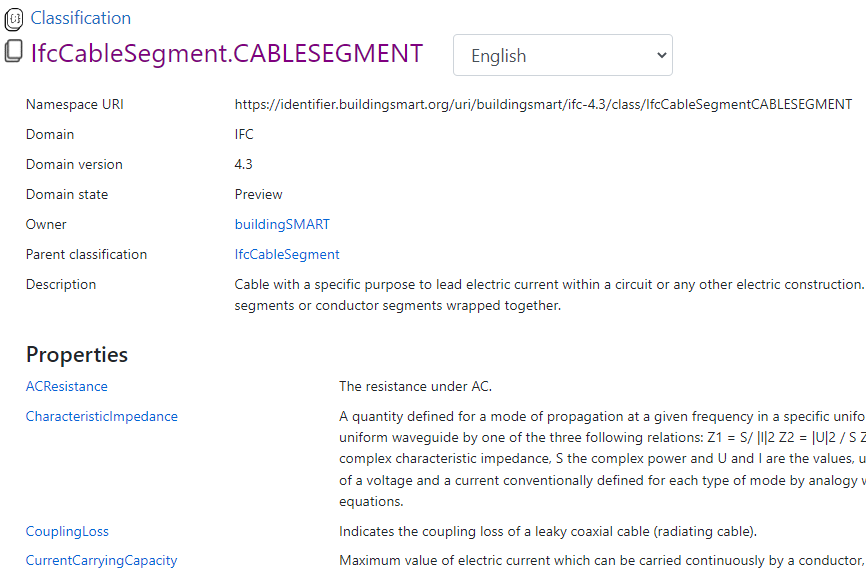
Uniform Identification
IfcCableSegment has also URI assigned by a data provider:
https://identifier.buildingsmart.org/uri/buildingsmart/ifc-4.3/class/IfcCableSegmentCABLESEGMENT
Uniform Identification
Non-unique identification violates FAIR Findability principle
F1: (Meta)data are assigned a globally unique and persistent identifier
Equal Data Retrieved from Different API
We have compared three representations returned by the bSDD server:
- JSON from the GraphQL API
https://test.bsdd.buildingsmart.org/graphiql/
- JSON from the REST (entity) API
curl https://identifier.buildingsmart.org/uri/buildingsmart/<domain>/class|prop/<name>and
- RDF from the REST (entity) API
curl -Haccept:text/turtle \https://identifier.buildingsmart.org/uri/buildingsmart/<domain>/class|prop/<name>
Equal Data Retrieved from Different API
We selected entities of each class that have the maximum number of filled fields, and compared the results returned by each API.
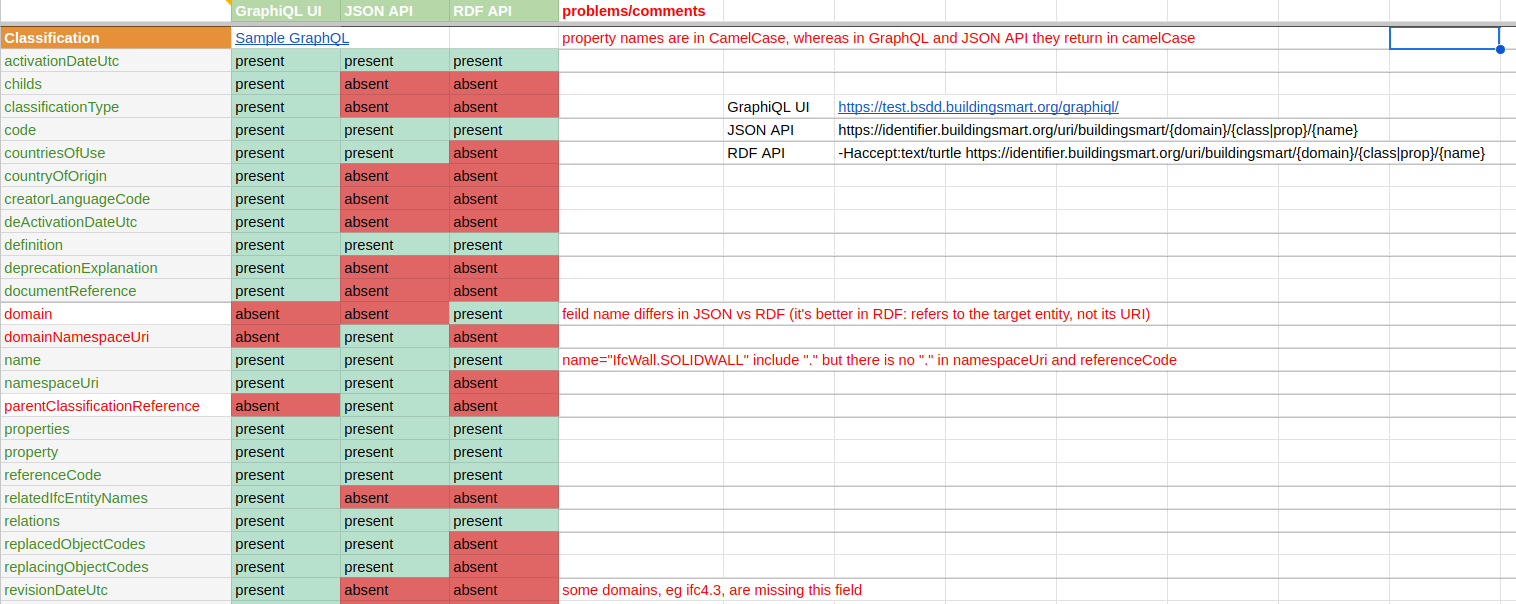
Improve URL Structure and Consistency
Almost all bSDD domain URLs now have the same structure:
https://identifier.buildingsmart.org/uri/<org>/<domain>-<version>URIs can be more “hackable”, allowing users to navigate the hierarchy by pruning the URI:
https://identifier.buildingsmart.org/uri/<org>/<domain>/<version>In some cases, the
<org>is repeated in the<domain>part
Improve URL Structure and Consistency
In some cases, the
<org>name doesn’t quite mesh with the domain name, perhaps due to the way bSDD allocates<org>identifiers to bSDD contributorsbim-de/DINSPEC91400: the publisher of this spec is DIN (the German standards organization), not thebim-deinitiativedigibase/volkerwesselsbv: bimregister.nl news from 2018 suggest thatdigibaseis a new company/initaitive within Volker Wesseldigibase/nen2699: the publisher of this spec is NEN (the Netherlands standards organization), not thedigibasecompany/initiativedigibase/digibasebouwlagen: perhaps the org namedigibaseshould not be repeated as the prefix of the domainbouwlagen(building layers)
Explicate domain versions
https://identifier.buildingsmart.org/uri/acca/ACCAtest-0.1
can become
https://identifier.buildingsmart.org/uri/acca/ACCAtest/0.1
A new entity DomainVersion can provide linking all versions of a domain to its master Domain entity.
Improve URL Structure and Consistency
- Declare URLs to be
IDand use a mandatory fieldid- Most GraphQL implementations call this field simply
id, whereas bSDD usesnamespaceUri - Many nodes do not have their own
namespaceUrifield, or it is not fully populated
- Most GraphQL implementations call this field simply
Entity Classes vs classificationTypes
The key field classificationType specifies the kind of classification.
| c | classificationType | overlaps with entity |
|---|---|---|
| 29 | “DOMAIN” | Domain |
| 18 | “REFERENCE_DOCUMENT” | ReferenceDocument |
E.g., there is the classification with name décret 2011-321 (23/03/2011) from ATALANE/REX-OBJ-1.0 domain and with classificationType=“REFERENCE_DOCUMENT”, that it is not in the list of ReferenceDocuments.
Why is it not a ReferenceDocument entity?
All entities should have URL
All significant classes should have ID, which in the case of RDF data is the node URL.
However, many bSDD classes don’t have such a field:
Domain, Property, Classificationdo havenamespaceUriCountry, Language, Unitdon’t have an ID but have a field (code, isocode) that can be used to make anID, when prepended with an appropriate prefix.
URL for ClassificationProperty
PropertyandClassificationPropertyare two different classes, but the latter does not have a distinct URL(*) in GraphQL and JSON.- The same URL is overloaded to identify entities of both classes.
ClassificationPropertyare not returned separately by the JSON or RDF entity API, but only as part of the respectiveClassification
E.g., IfcCableSegment.CABLESEGMENT classification has ACResistance as a ClassificationProperty, but
curl https://identifier.buildingsmart.org/uri/buildingsmart/ifc-4.3/class/IfcCableSegmentCABLESEGMENT/ACResistancereturns
{"":["Classification with namespace URI
'https://identifier.buildingsmart.org/uri/buildingsmart/ifc-4.3/class/IfcCableSegmentCABLESEGMENT/ACResistance' not found"]}Modelling issues
Unify Solutions to Model Complex Properties
The key attribute propertyValueKind has values COMPLEX and COMPLEX_LIST used in combination with connectedProperties. These key values are defined for Property and ClassificationProperty
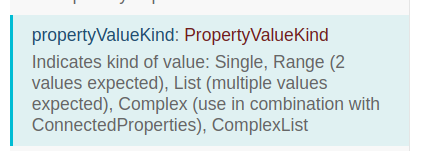
- However,
connectedPropertyCodesis defined only forProperty - More importantly, these key values are never used
connectedPropertyis used only on 7Properties(and notClassificationProperties)- Instead of using
connectedPropertyCodesto describe complex properties, some providers have used classifications with the type COMPOSED_PROPERTY.
Improve Modelling of Dynamic Properties
12385 Properties are declared with isDynamic=true
135250 are not.
However, the field dynamicParameterPropertyCode (used to compute the dynamic property) is always empty, so how can one know which “sub-properties” to use?
Additionally, dynamicParameterPropertyCodes is String, but should be [Property], i.e. an array of Properties .
Improve Relations Between Entities

Add More Entities
bSDD includes numerous string attributes (codes or URLs) that should be converted to relations (object fields) to improve the connectedness of the bSDD GraphQL graph
| is a classification field (String) | should be |
|---|---|
physicalQuantity |
(New) PhysicalQuantity |
propertySet |
(New) PropertySet |
subdivisionsOfUse |
(New) CountrySubdivision |
version |
(New) DomainVersion |
replaced/(-ing)ObjectCodes |
some kind of objects. Currently they are empty |
Use Class Inheritance
Property and ClassificationProperty: have 46 fields in common, differ in only 5 fields:
belongs uniquely to Property |
belongs uniquely to ClassificationProperty |
|---|---|
connectedPropertyCodes (String) |
isRequired (Boolean) |
relations (PropertyRelation) |
isWritable (Boolean) |
predefinedValue (String) |
|
propertySet (String) |
|
symbol (String) |
Since there are no rules on which fields of Property to reuse in ClassificationProperty, the latter type copies most of the fields from the former.
Improve PropertyValues
PropertyValueandClassificationPropertyValueare structured values with rich fields:
code, value, namespaceUri, description, sortNumber
- However, most structured values we’ve seen have only
code, value.
This has multiple problems:
- Individual values have no description (
descriptionis not filled out) - Some values are described in the property definition, intermingling multiple descriptions together
- The “standard” values NOTKNOWN, OTHER, UNSET are not described at all.
- Values have no
namespaceUri, precluding unique identification.
- Individual values have no description (
Improve predefinedValue
allowedValuesstore structured values (ClassificationPropertyValue)However, their “sibling” property
predefinedValueholds just a String, which means that even in the future,predefinedValuecannot be an enumeration value identified globally with a URL.
Improve Multilingual Support
- bSDD is advertised as a multilingual dictionary
- In the GraphQL API, one can specify a desired language(*) when fetching classifications and properties
- However, currently most domains are present in one language only (unilingual).
Data Quality
Data Quality Issues
- Leading, trailing, consecutive whitespace
- Improve physical quantities and units
- No rules on missing data
- Unicode problems
- Unresolved HTML entities
- Bad classification relations (broken links)
Implementing Improvements
Implementation Steps
We implemented a lot (but not all) of the improvements suggested above by using the following process:
- Fetch bSDD data as JSON
- Draft SOML schema
- Convert it to RDF using SPARQL Anything
- Load it to GraphDB
- Refactor the RDF using SPARQL Update
The results are available at the SPARQL endpoint and in GraphQL
Conclusions and Future Work
Here are further ideas for improvement:
- improve bSDD ontology
- implement more radical data model refactoring to convert “strings” (countries, reference documents, etc.) into “things”
- link bSDD units of measure to QUDT ontology
- perform deeper data quality analysis using SHACL shapes generation and validation provided by Ontotext Platform Semantic Objects
- address and resolve more data quality issues, including
- seek correlation between dimension vectors, units of measure and physical quantity,
- parse out enumeration values from
Property/ClassificationPropertydescriptions and create correspondingPropertyValuelists
- make more graph visualizations
- obtain more interesting statistics using SPARQL
Acknowledgements




Funding: ACCORD project, Horizon Europe, grant #101056973
Data: buildingSMART Data Dictionary (Leon van Berlo, Artur Tomczak, Erik Baars)
Powered by:

11th Linked Data in Architecture and Construction Workshop, 15–16 June 2023, Matera, Italy




